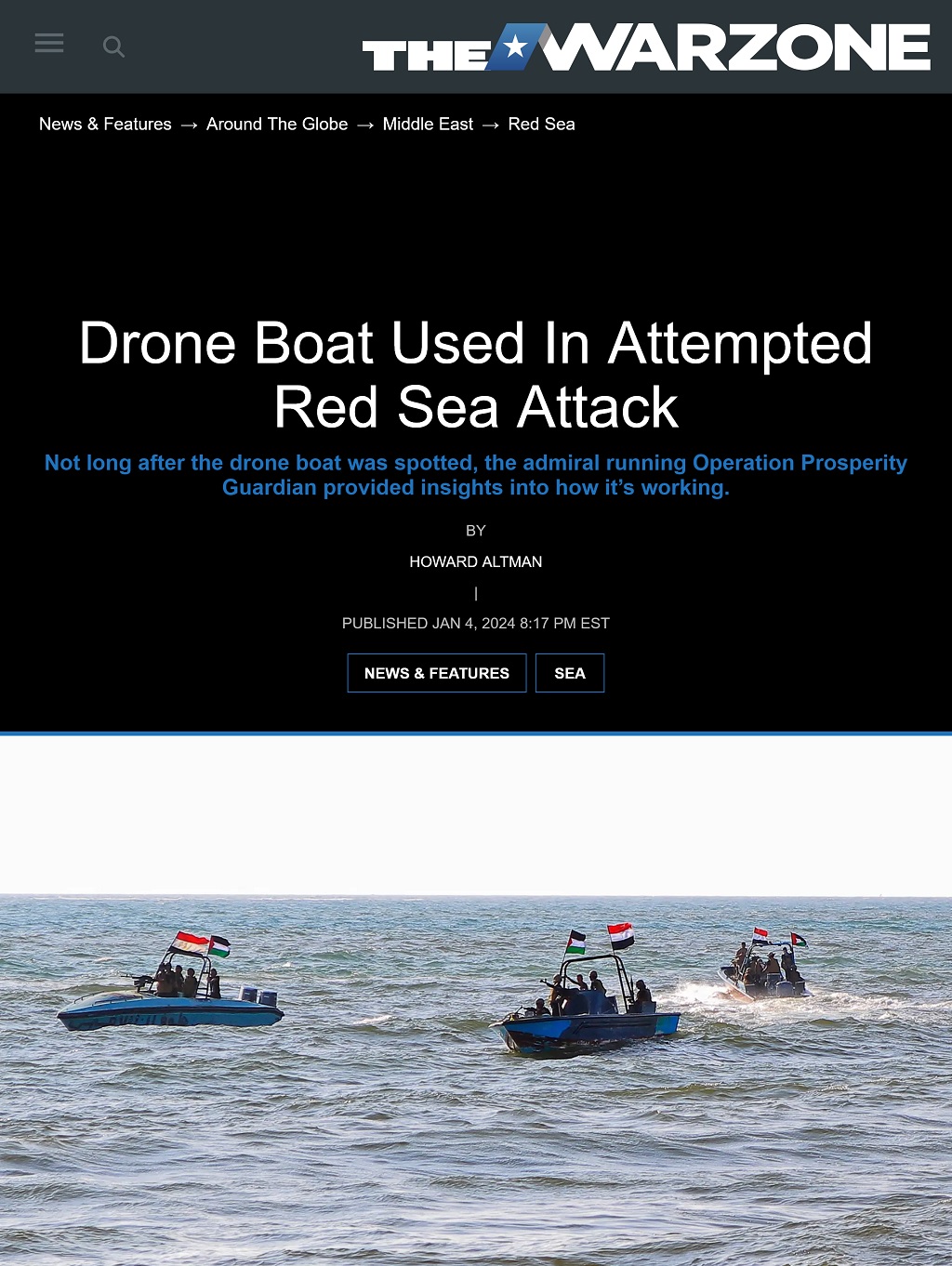Not long after the drone boat was spotted, the admiral running Operation Prosperity Guardian provided insights into how it’s working.
The Houthis have introduced unmanned surface vessels (USVs) to their current array of threats to Red Sea shipping. While the Yemeni militant group has used crude drone boats before — they actually pioneered the operational use of kamikaze USVs years ago — these weapons have not appeared in the current crisis until today.
The USV “detonated in international shipping lanes,” Vice Adm. Brad Cooper, Commander of U.S. Naval Forces Central Command (NAVCENT), told reporters, including from The War Zone. “Fortunately, there were no casualties and no ships were hit, but the introduction of a one-way attack USV is of concern.”
Image: The Houthis launched their first uncrewed surface vessel (USV) in the Red Sea since the start of the Israel-Hamas war, a top U.S. Navy admiral said Thursday. (Google Earth image)
The Houthis have staged 24 previous missile, aerial drone and manned boat attacks on Red Sea shipping since Nov. 18, including the Nov. 20 hijacking of the Bahamian-flagged vehicle carrier ship Galaxy Leader which you can see in the video below.
However this was the first time, Cooper told The War Zone, that one of their USVs was used since beginning their campaign they say was launched to help Palestinians suffering during the ongoing Israel-Hamas war.
“They have previously employed them years past,” he noted. We first reported about this capability in January 2017, when an explosive-laden Houthi USV struck a Saudi frigate, which you can see in this video. Iran developed various crude kamikaze USVs years ago and those weapons soon migrated to their Houthi proxies, which they were first used.
Video: فيديو يؤكد الهجوم الانتحاري على الفرقاطة السعودية
The USV that attacked on Thursday transited about 15 miles into the waterway from the Houthi-controlled territory in Yemen, Cooper said, adding he did not know why it detonated.
“The USV itself was also in the dense lanes, came within a couple of miles of merchant ships and U.S. Navy ships. And we all watched as it exploded.”
Other than Cooper’s description of this USV as a “low-profile unmanned surface vessel,” we don’t know many details about it. However, since the Houthis first introduced kamikaze USVs as a weapon, they have evolved greatly. Ukraine, as we have frequently reported, has made tremendous advancements in this field and used them extensively against Russian ships as well as in a destructive attack on the Kerch Bridge in July 2023.
Defensive Operation
Today’s USV attack came hours before Cooper, leading a new international effort to protect Red Sea shipping called Operation Prosperity Guardian (OPG), held a previously scheduled briefing to provide additional insights into how it’s performed so far.
Despite these ongoing attacks, OPG is a defensive operation and will not be part of any retaliation against the Houthis, Cooper said. Yesterday, the U.S. and 12 other nations issued a joint warning to the Houthis demanding they stop these attacks or face unspecified consequences. You can read more about that in our initial reporting here.
Cooper said OPG will have no role in that.
“Anything that happens outside of the defensive aspect of this operation is a completely different operation,” he stated.
There are currently five warships from three nations – the U.S., U.K. and France – working with OPG. Denmark and Greece have promised additional vessels.
Image: The Type 45 destroyer HMS Diamond is one of the vessels protecting Red Sea shipping as part of Operation Prosperity Guardian (Royal Navy photo) Royal Navy
Those warships ships are operating “in specific areas spread out over the length of the southern Red Sea,” Cooper explained.
The vast majority of the time, they are “very actively patrolling…alongside with and defending a large group of merchants who are transiting.”
On rare occasions, he added, those warships will shift to “escorting or being close to a group of ships for extra-close overwatch.”
Aside from ships, there are also aviation assets working with OPG.
“We have manned and unmanned reconnaissance aircraft, and as I think you’ve seen, we’ve seen tactical aircraft and jets from USS Dwight D. Eisenhower, the U.S. aircraft carrier deployed to the region,” said Cooper.
Image: Helicopters and F/A-18 Super Hornets from the aircraft carrier Dwight D. Eisenhower have defended against Houthi attacks in the Red Sea. (Eisenhower Facebook page photo)
As we reported previously, on Dec. 26, the Arleigh Burke class destroyer USS Laboon and F/A-18 Super Hornets from the Eisenhower Carrier Strike group shot down a dozen one-way attack drones, three anti-ship ballistic missiles, and two land attack cruise missiles.
Five days later, on Dec. 31, MH-60 Sea Hawk helicopters from the Eisenhower and the Arleigh Burke class destroyer USS Gravely responded to a distress call from a merchant vessel under attack from Houthi boats on Dec. 31.
Image: A helicopter from the Arleigh Burke class guided missile destroyer USS Gravely took part in an attack on Houthi ships menacing a commercial vessel in the Red Sea. Photo by Petty Officer 1st Class Ryan Seelbach
“In the process of issuing verbal calls to the small boats, the small boats fired upon the U.S. helicopters with crew-served weapons and small arms,” U.S. Central Command said at the time. “The U.S. Navy helicopters returned fire in self-defense, sinking three of the four small boats, and killing the crews.”
Cooper said that since the launching of OPG, participating warships have shot down 11 aerial drones, two cruise missiles and six anti-ship ballistic missiles. The U.S. Navy alone has downed 61 Houthi missiles and aerial drones since Nov. 18, Cooper highlighted.
Since the start of the operation, “no Houthi UAV or missiles fired into international shipping lanes hit any merchant vessels,” said Cooper. “Some have come close but no hits.” Meanwhile, “about 1,500 vessels have safely transited through the Bab al-Mandab” Strait since OPG became operational.
And while several warships have engaged Houthi weapons, “there’s no specific information that any U.S. [warship] has been directly targeted.”
Additional Resources
OPG operates under the command of an 18-month-old international effort called Combined Maritime Forces (CMF) Task Force 153, said Cooper. However, prior to the Houthis launching their attacks, there was no need for such a sustained presence of ships in the southern Red Sea. OPG was formed to add additional resources.
“I think we have a sufficient number of assets to execute the tasking I’ve been given,” said Cooper. “It’s not just about the surface ships. As I mentioned, we also have airborne reconnaissance… And we have the strength of the Carrier Air Wing operating proximity.”
Image: F/A-18 Super Hornets from the aircraft carrier Dwight D. Eisenhower are part of the effort to protect Red Sea shipping. (U.S. Navy photo by Mass Communication Specialist 3rd Class Jonathan Snyder/Released)
Reinforcements are on the way, he added, but that will take a little time.
“In terms of our partners, really this is just a time, speed, distance challenge. You could probably do the math on how long it takes you to get from Denmark to all the way around Europe, through the Mediterranean, Suez Canal and down to the southern Red Sea. That takes a couple of weeks, and we’ll look forward to them as well as other partners showing up then.”
So far, there are 22 nations involved, though many have opted not to publicly announce their participation. The vast majority have committed staff officers, not vessels, but Cooper said he hopes that more will contribute warships as well.
The increased presence of warships in the southern Red Sea “does a couple of things,” said Cooper.
It serves as “an assurance to the commercial industry. They’ve provided this feedback directly to us on multiple occasions. Particularly relevant is we’re out operating at sea, and they see something, they can say something and get a very quick response. I think that’s been very helpful.”
In addition, “by being present in a more persistent manner, given the Houthis’ intent to continue these attacks, we’ve been able to defend” commercial shipping. “So I think our persistent presence has put us in the position with the greater defensive posture than had been.”
OPG has not gone without some hiccups. Spain and Italy have opted not to send ships while questions have arisen about the level of participation from France. Some reporting has suggested France only wants to operate under the control of its own Navy or protect its own interests.
However, one French official told The War Zone that “France contributes to Operation Prosperity Guardian and more globally to restoring maritime security in the Red Sea. FS Languedoc has been deployed in the area for some time. There has been a number of fake news disseminated on social media about France leaving the operation. That is not the case.”
Image: The FREMM Languedoc, patrolling off the coast of Yemen, is France’s contribution to Operation Prosperity Guardian. (French Navy photo)
Asked about the French participation, Cooper was vague.
“We are operating side-by-side virtually every day. It’s going well. We’re very appreciative.”
The Houthis, meanwhile, are urging nations to opt against joining OPG.
So far, it appears that most Arab nations have heeded the Houthi request. Bahrain is the only one to publicly join OPG.
As we discussed in a previous story, while the Saudis have a huge stake in what happens in the Red Sea, they are both trying to end a long and costly conflict with the Houthis and mend fences with regional rival Iran.
Egypt, which owns the Suez Canal, also has a major interest in the success of OPG, with nearly $10B a year in revenue earned from canal operations.
Cooper said he was “proud” that Bahrain, the host nation for this effort, is taking part. Like other U.S. military officials in the past, he deferred questions about to the other Arab nations about their level of participation.
Whether they participate, and how many other nations ultimately contribute vessels and aircraft, remains to be seen.
Contact the author: howard@thewarzone.com


